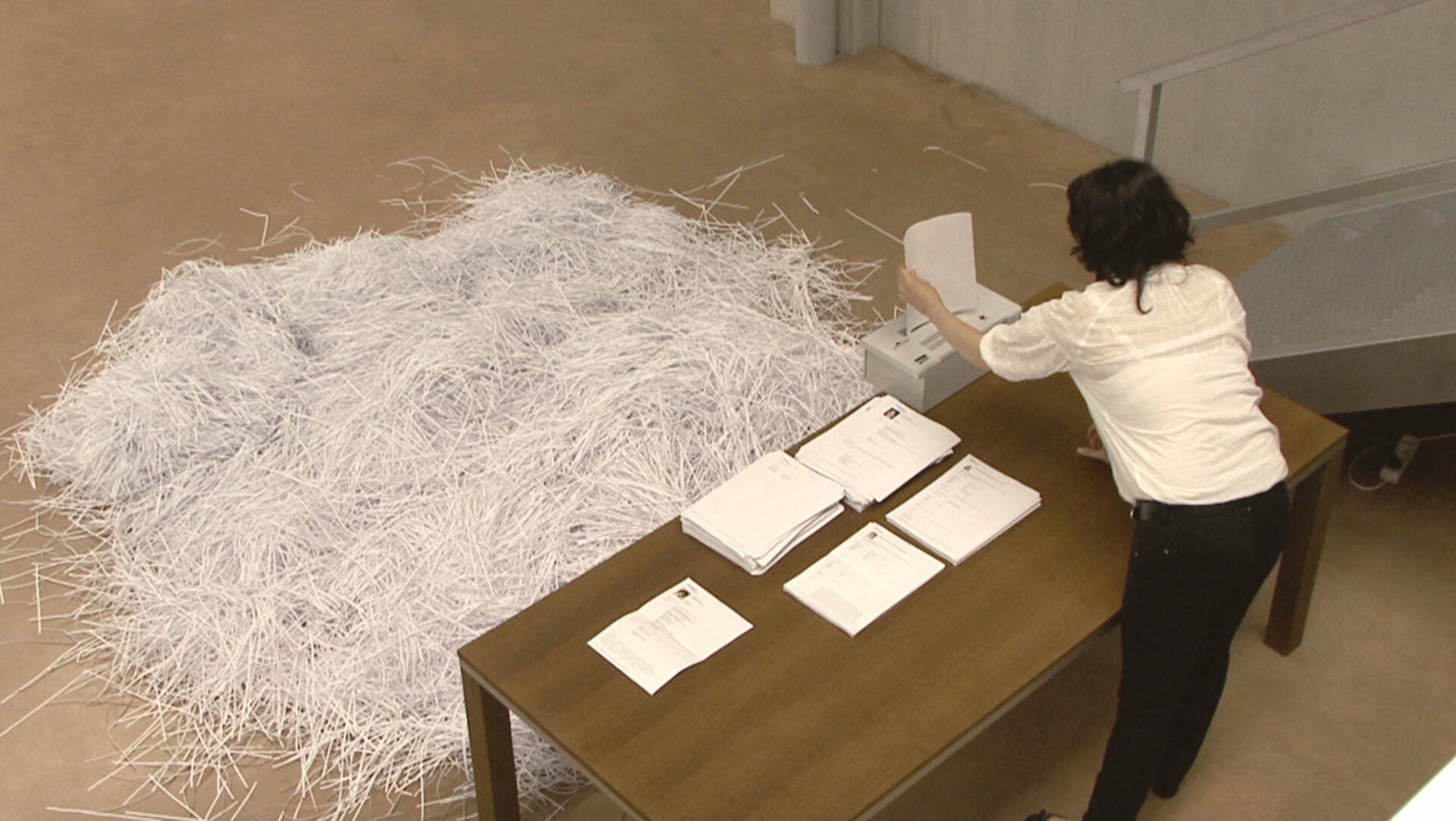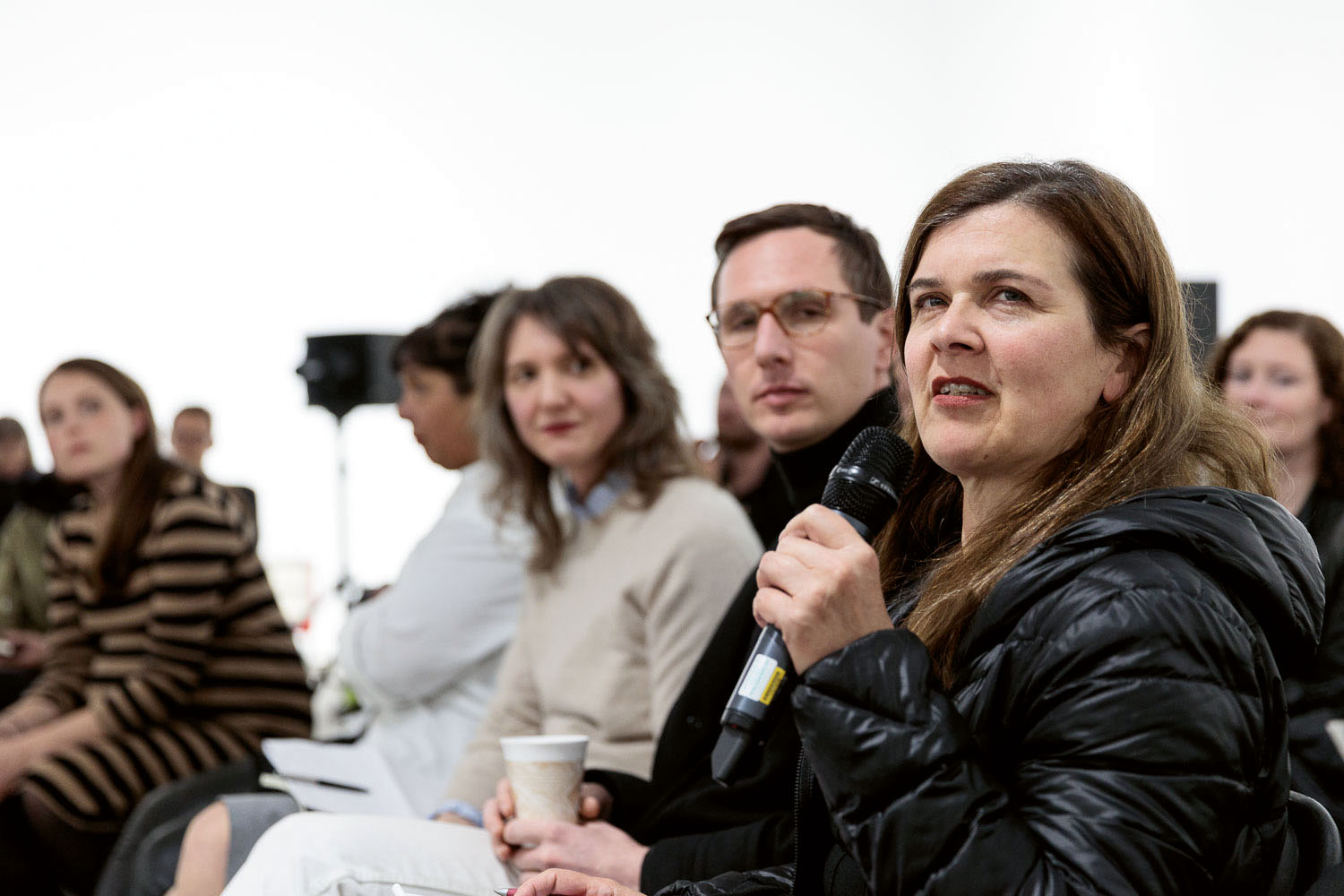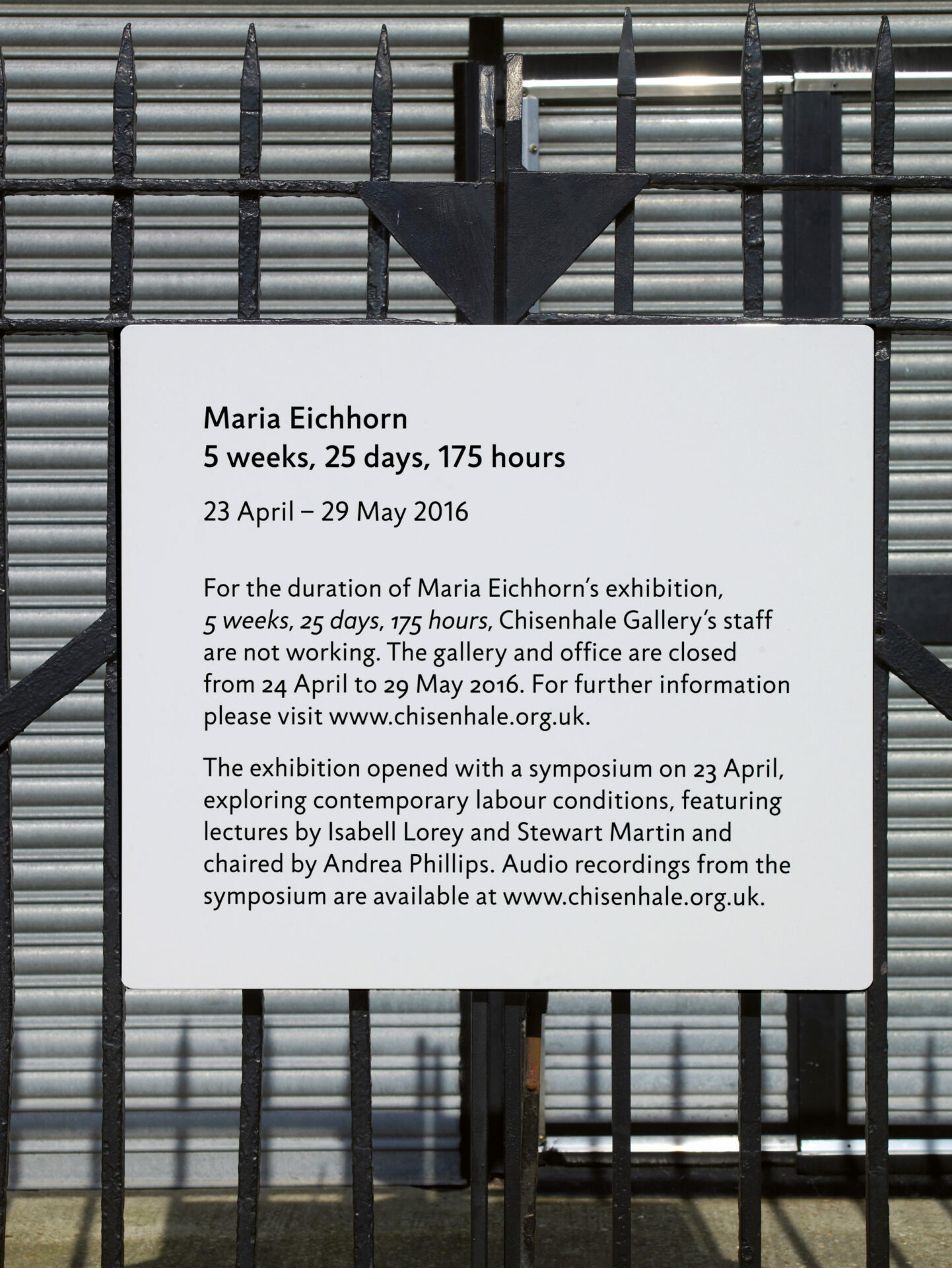
In Search of Unproductive Time
With the development of new technologies — particularly the smartphone — the working hours of the employed are even encroaching on their leisure time and personal lives, escalating stress and burnout without increasing productivity. Artists, whose activities are perceived, often with envy, as free and little constrained by routine, are also facing these changes. Not only do the demands of being visible in a competitive world require knowing how to manage one’s activities like a business, in terms of organization and communication, but most artists often also face the reality of taking jobs in order to “make ends meet.” In their art practices, some artists are increasingly implicating themselves in the reality of the working world. They sometimes even intervene directly by becoming employers in order to better highlight its aberrations or attempt to generate unproductive time. In this, they are anticipating a world without work, in which freed time would allow for the creation of individual and collective projects, and thus helping to redefine “work” as something no longer determined by the earning of wages.3 3 - This is compatible with accelerationist theories. See Nick Srnicek and Alex Williams, Inventing the Future: Postcapitalism and a World Without Work (Brooklyn: Verso Books, 2016).
Toward a World Without Work
With higher productivity at constant working hours, capitalism has not only given rise to a high unemployment rate but has also contributed to the creation of a significant number of meaningless jobs, burying a plethora of wage-earners in a chain of production whose stakes and purposes they do not understand.4 4 - David Graeber, Bullshit Jobs: A Theory (New York: Simon & Schuster, 2018). In Surplus Production Line, Cuban artist Adrián Melis addresses the question of pointless work and the overqualification of wage-earners working in unrewarding jobs. In 2014, he set up a business in Barcelona that offered someone a temporary job for one month (two hours per day, five days a week), thus engaging with Spain’s economic reality, in which most people are unemployed. He interviewed five people after receiving 2,768 résumés. The completely absurd job of the person selected consisted of destroying the résumés of those who did not get the job.
In the video showing the employee carefully accomplishing this task with a paper shredder, typical job interview questions appear on the screen: “What kind of administrative experience have you had before? ” “What makes you the best person for this job? ” Although she has a degree in graphic design, the forty-year-old employee states that she’s always done admin-istrative tasks and that she would like a job that makes her happy, but she’s never had one. Although the activity offered by Melis’s business does not require any skill, the employee cannot be sloppy, as she needs to insert the sheets of paper into the machine slowly, one by one, so that the shredder does not jam.


Surplus Production Line, video stills, 2014.
Photos : courtesy of the artist & Adn Galeria, Barcelona
The employee is thus transformed into an automaton. With the pile of shredded paper in his installation, Melis addresses the issue of the division of labour in a society in which such division occurs less and less, as well as the lack of job security and the increase in administrative tasks valued by the ruling class, managers, and administrators. Few of these tasks are actually productive; it is as if some people have to do this type of work in order to create the illusion that everyone works. New industries, such as financial services, telemarketing, corporate law, academic and health administration, human resources, and public relations, ultimately have no or little social value.5 5 - David Graeber, “On the Phenomenon of Bullshit Jobs: A Work Rant,” Strike! 3 (August 2013), https://strikemag.org/bullshit-jobs. The tasks carried out in these contexts often lead only to extreme boredom. By creating an uninteresting job, the only goal of which is to earn money, Melis also reveals the absurdity of work determined solely by the earning of wages.
Being Paid to Not Go to Work
The debate over a universal basic income makes those opposed to this idea fear that people would no longer feel like working. The risk is real if we take into consideration meaningless jobs. In Cuba, the system of production allows so few workers to feel fulfilled that absenteeism has become the norm. In The Value of Absence. Excuses to be absent from your workplace (2010–12), Melis highlights this lack of motivation. For this project, he offered to pay workers for finding good excuses to not go to work for a period ranging from one day to one month. The installation, composed of a desk and a TV monitor, presents recordings of the telephone calls that workers made to employers to give their excuses. Three hundred and twenty-seven days, which is almost a year of work, were thus exempted. In the list of excuses provided by the artist are standard justifications related to health or family issues and household accidents, but also others that are more startling once we know that the employers did not challenge them: going to the beach with friends, having lunch with the family, not feeling like working, being asleep, having their television stolen, having their mother visit, going to see the psychoanalyst, and so on. The lack of motivation is so high that the workers seem to be playing along very easily. Absenteeism is increasing in all economic sectors, including in capitalist countries.6 6 - In France, for example, see Gaëlle Picut, “L’absentéisme touche un tiers des salariés français,” Le Monde (September 15, 2015), lemde.fr/2K5QWW3. We have never skipped out on work as much as we do today. Some of the causes most often mentioned include musculoskeletal injuries and stress, the flip side of boredom.

The Value of Absence. Excuses to be absent from your workplace, 2010-2012, installation view, Adn Galeria, Barcelona, 2012.
Photo : Roberto Ruiz, courtesy of the artist
Although many studies show that productivity is not determined by the amount of time we spend in an office or a business, overwork is a statutory sign implying that one is important and interesting, whereas taking time for oneself is always seen as a sign of laziness.7 7 - Bregman, Utopia. The moral dimension associated with work remains strong. The video The Working Life (2013) by the collective Superflex offers a coping strategy through therapeutic means: a hypnosis session lasting nine minutes and fifty seconds, the objective of which is for a person not to feel shame at the idea of not working. The video begins with a therapist asking the viewer to imagine being in a building in which hundreds of people are working: “Imagine how it is to be one of those really busy workers…” “Feel how it would be to be part of this working community…” “Working with your colleagues makes you feel good; you know exactly what you’re supposed to do…” In the middle of the session, a disruption occurs: “Now see your hands moving faster and faster and faster…” “Your colleagues are smiling, but you cannot recognize their faces anymore…” “You search through the corridors of the large building looking for some sense of the work you should be doing. You’re running… You’re panicking; you don’t know why.” The therapist’s face moves closer and closer to the camera. He then gives the injunction to stop, go into a room, and lock the door. “Sitting there, lazy, useless, unproductive…” “There’s nothing to be a-shamed of.” The end of the session encourages the viewer to feel free: “You’re not working anymore; you’re not the least ashamed.” Once the issue of morality is separated from the fact of not working, the issue of newfound freedom arises. So then the question becomes what to do with this freedom.
Having Free Time in Exchange for Nothing
Under these conditions, giving time in exchange for nothing might constitute a real societal and political challenge. In 2016, for 5 weeks, 25 days, 175 hours, Maria Eichhorn closed the Chisenhale Gallery in London for more than five weeks, or 175 working hours, during which time the gallery employees did not work. Her idea was to suspend the capitalist logic of exchange that gives free time without compensation and see how employees would use their free time while still retaining their salaries. In order to avoid people working remotely by email, the artist set up a system whereby the messages received during this period would be deleted, and the senders would receive an automatic response asking them to write again once the employees were back at work.8 8 - Katie Guggenheim and Polly Staple, Maria Eichhorn: 5 weeks, 25 days, 175 hours (London: Chisenhale Gallery, April 2016). Preceded by a symposium addressing questions of free time, responsibility, and work commitment, the exhibition illustrates the difficulty of creating such time. Some employees had reservations about not working for five weeks. The gallery director, Polly Staple, explains that her typical workload, which consists mainly of raising money, leaves her little time for reflecting on other important aspects such as art research. This relatively uninteresting work absorbs her completely, even outside gallery hours. However, we do not find out whether the five free weeks allowed her to give free rein to thinking about art.
Reclaiming Unproductive Time
Calling for people not to work, in accordance with Guy Debord’s slogan, the Situationists believed that claiming free time is eminently political.9 9 - This is also the case for André Gorz, “Vers une révolution du travail: Bâtir la civilisation du temps libéré,” Le Monde diplomatique (March 1993): 13, monde-diplomatique.fr/1993/03/GORZ/45105. David Graeber also points out that the “ruling class has figured out that a happy and productive population with free time on their hands is a mortal danger.”10 10 - Graeber, “Phenomenon.”[/REF)
In 1995, Pierre Huyghe created the Association des temps libérés (Association of Freed Time), the mandate of which was “to develop unproductive time, reflect on free time, and create a society without [NOTE count=11]work.”[/NOTE]The statement appeared in Journal Officiel on July 5, 1995. Conceived in response to an invitation to participate in the Moral Maze exhibition at Le Consortium in Dijon, this project should be understood as a general call to reclaim time for imaginative play. Activity freed from any production is set in opposition to work. The legal purpose of the association specified that it would disseminate its ideas by organizing “various public meetings, talks, publications, celebrations.” As might be expected from this description, few projects came out of this association.12 11 - The House or Home? (1995), a project for which the artists would purchase a house with the idea of offering unproductive time, and Temporary School (1996), for which Dominique Gonzalez-Foerster, Pierre Huyghe, and Philippe Parreno organized workshops that they had been invited to give.

5 weeks, 25 days, 175 hours, symposium, Chisenhale Gallery, London, 2016.
Photo : Mark Blower, courtesy of the artist


5 weeks, 25 days, 175 hours, installation views, Chisenhale Gallery, London, 2016.
Photos : Andy Keate, courtesy of the artist
Nevertheless, the legal purpose echoes Huyghe’s ideas on free time, which he developed over several years. In 1996, when he was invited to lead a workshop at the École municipale des beaux-arts de Châteauroux, he rented a bus and took the students on vacation. After exempting them from their objective by posting a sign on the gallery door that read “On vacation (gallery closed for the duration of the exhibition),” he took them down the memory lane of his childhood and into Spain while showing them films that had been important for him. He is not interested in appealing to laziness or idleness, but in reclaiming time that is separated from any demands of production. Three years later, Huyghe seems to have questioned the actual possibility of such appropriation. Le procès du temps libre, partie 1 : Les indices (The Trial of Free Time, Part 1: Clues)(1999), in which the clues include a reference to Paul Lafargue’s The Right To Be Lazy, a poster of a naked woman lying in a field, and a sheet of paper featuring an empty program by Marcel Broodthaers, seems to constitute an unattainable conceptual land-scape. In an interview with Hans Ulrich Obrist in 2006, Huyghe stated that he was uncertain that time really belonged to him: “I’ve made use of my free time, but perhaps free time does not belong to me, my vacation time does not belong to me! ”13 12 - “Entretien avec Hans Ulrich Obrist,” Pierre Huyghe: Celebration Park, ex. cat. (Paris: Paris musées, les musées de la Ville de Paris, 2006) (our translation). Indeed, free time itself is in danger of being taken over by capitalism: “Leisure time has undergone a double transformation: on the one hand, it is a time of consumerism; on the other hand, it is a time of ‘diversion’ in the sense of ‘that which diverts,’ that which allows us to look elsewhere and forget our real-life worries as we distract ourselves with a spectacle.”14 13 - Thomas Schauder, “Le ‘temps libre’ dans cette société du divertissement fait-il notre bonheur? ” Le Monde (April 18, 2018), https://lemde.fr/2K2vktL (our translation).
It is appropriate today for artists to examine the issue of work and the influence of the market economy on their activities. Work, in the sense of artistic activity as an accomplishment in itself — “real work” in the Marxist sense — is being increasingly swallowed up by poly-active business activity that often goes hand in hand with unrewarding paid activity. Artists must also deal with new ways of managing their activity. As Pierre-Michel Menger points out, artists’ incomes are not only related to their skill or talent, but are partly dependent on their organizational and business skills.15 14 - Pierre-Michel Menger, The Economics of Creativity: Art and Achievement Under Uncertainty, trans. Steven Rendall et al. (Cambridge: Harvard University Press, 2014). The administrative pressure to complete applications and manage them is increasing. A rising convergence between the work of artists and that of other workers then becomes noticeable. Furthermore, artists are not protected from burnout, as the case of Jeppe Hein demonstrates; Hein’s burnout was publicized before it led to a different and apparently more fulfilling art practice.16 15 - Finn Janning, The Happiness of Burnout: The Case of Jeppe Hein (Cologne: Koenig Books, 2015).
The general loss of meaning increasingly makes workers want to seek fulfilment by creating their own activities in alignment with the specificity of artistic activity: independent work that is modeled on uncertainty17Menger, Economics of Creativity.[/REF] and that blurs the boundaries between work and leisure. It is therefore not surprising that artists are concerned about the decrease of their unproductive time and that they seek to contribute to sociopolitical thought on creating free time.
Translated from the French by Oana Avasilichioaei
